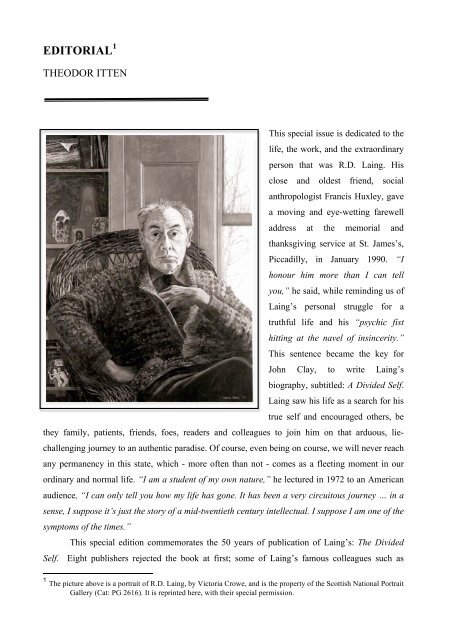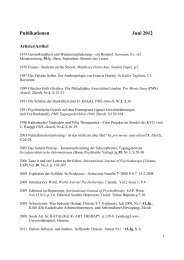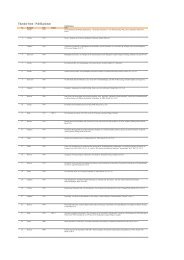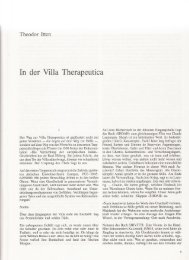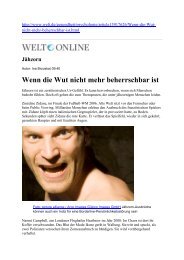EDITORIAL1 - Theodor Itten
EDITORIAL1 - Theodor Itten
EDITORIAL1 - Theodor Itten
You also want an ePaper? Increase the reach of your titles
YUMPU automatically turns print PDFs into web optimized ePapers that Google loves.
EDITORIAL 1<br />
THEODOR ITTEN<br />
This special issue is dedicated to the<br />
life, the work, and the extraordinary<br />
person that was R.D. Laing. His<br />
close and oldest friend, social<br />
anthropologist Francis Huxley, gave<br />
a moving and eye-wetting farewell<br />
address at the memorial and<br />
thanksgiving service at St. James’s,<br />
Piccadilly, in January 1990. “I<br />
honour him more than I can tell<br />
you,” he said, while reminding us of<br />
Laing’s personal struggle for a<br />
truthful life and his “psychic fist<br />
hitting at the navel of insincerity.”<br />
This sentence became the key for<br />
John Clay, to write Laing’s<br />
biography, subtitled: A Divided Self.<br />
Laing saw his life as a search for his<br />
true self and encouraged others, be<br />
they family, patients, friends, foes, readers and colleagues to join him on that arduous, liechallenging<br />
journey to an authentic paradise. Of course, even being on course, we will never reach<br />
any permanency in this state, which - more often than not - comes as a fleeting moment in our<br />
ordinary and normal life. “I am a student of my own nature,” he lectured in 1972 to an American<br />
audience, “I can only tell you how my life has gone. It has been a very circuitous journey … in a<br />
sense, I suppose it’s just the story of a mid-twentieth century intellectual. I suppose I am one of the<br />
symptoms of the times.”<br />
This special edition commemorates the 50 years of publication of Laing’s: The Divided<br />
Self. Eight publishers rejected the book at first; some of Laing’s famous colleagues such as<br />
1 The picture above is a portrait of R.D. Laing, by Victoria Crowe, and is the property of the Scottish National Portrait<br />
Gallery (Cat: PG 2616). It is reprinted here, with their special permission.
Winnicott critically supported this work; others like Bowlby had their strong reservations. When<br />
the book came out in a Penguin paperback edition in 1965, it sold over 380,000 copies in the first<br />
five years, to Laing’s great surprise. It continues to sell very well indeed and has been translated<br />
into virtually every other language in which books are published (Smith, 1982).<br />
When Victoria Brittain interviewed Laing in 1972, after his return from his sabbatical in<br />
Sri Lanka, he saw the success of The Divided Self, “… as a reflection of how many people knew<br />
the uncomfortable experience of living with an inner reality which does not correspond to the<br />
apparent outer reality of the world.” (Brittain, 1972) In other words, we are living within a family<br />
embedded in a society, which teaches us to play roles and fulfill functions, which cut us off, “…<br />
from our deepest feelings and needs: it alienates us from ourselves.” (Berman, 1970)<br />
Few people at that time had been able to get through to patients hiding their true self within<br />
a closed schizophrenic world. Laing was able to make this form of “being-in-the-world”<br />
intelligible. He explored the soul’s underworld journey into madness even further, while still<br />
returning to tell the tale. In giving Jesse Watkins, the late well-known sculptor, room in The<br />
Politics of Experience (in Chapter 7), to recount his Ten-Day Voyage, full of painful treasures<br />
from having gone inside and downwards, thereby freeing himself from his anxiety of living his<br />
life, letting go of the protective false self, which served as a detached, disembodied hiding place<br />
for his core being.<br />
“When I came out of hospital, I was there for about three months altogether, when I<br />
came out I supposedly felt that everything was much more real and that it – than it had<br />
been before. The grass was greener, the sun was shining brighter, and people were<br />
more alive, I could see them clearer. I could see the bad things and the good things<br />
and all that. I was much more aware.” (Laing, 1967)<br />
Watkins describes how he was suddenly enriched with an enormity of inner and outer knowing.<br />
He experienced his journey, as numerous others have done after and before him, as a natural way<br />
of healing.<br />
In his first famous work, The Divided Self^, Laing, a specialist in events in inner space and<br />
time, made a deep impact in his appeal that the plight of those among us, who suffer from mental<br />
disturbance, needs to be taken absolutely seriously. My wish, to put pen to paper in order to<br />
commemorate this event half a century ago, went out to a few colleagues and friends. For once I<br />
chose to ask others and not the same dear old folks, who have already, since his death 22 years<br />
ago, written extensively about Ronnie Laing.<br />
His books, The Divided Self, The Self and Others, The Politics of Experience, Knots, and<br />
The Politics of the Family, as well as his advocacy for expressed emotions and clarification of<br />
mystification in Sanity, Madness and the Family all made a profound impact on our profession<br />
and on lay people. John Clay brought this to a point:
“Many readers felt their own voices were being articulated for the first time; Laing’s<br />
genius lay in the ability to say what so many knew intuitively, but had never thought to<br />
articulate before. His writings touched people’s secret minds.” (Clay, 1996, p. 270)<br />
Some of us, assembled in this special issue, have known him personally as friend, colleague and<br />
teacher. The younger ones only know him from his work either through his writing, lectures or<br />
film appearances. So what is on offer?<br />
First ‘his masters voice’, Laing himself was broadcast on Swiss-German-Radio, DRS2, on<br />
4 th January 1983. Here, you can read the first publication of the transcript of that broadcast.<br />
Befitting a long friendship, Francis Huxley, comes second to none, with his obituary<br />
words, spelling out his sympathy for Laing, whilst not flinching from shining his torchlight on his<br />
darker sides.<br />
Philosopher Ljiljana Filipovic, from Zagreb, takes up the thread, which she explored in her<br />
book on Laing, challenging our profession and society by questioning the meaning and role of the<br />
psychotherapist professionals, as well as the concepts of sanity and madness which form the<br />
axiomatic ground for theory-making.<br />
As befits demystifying mystifiers like Laing, David Abrahamson’s reflects on Laing’s and<br />
others discrepant accounts of the by-now well-known ‘rumpus room’ experiment at Gartnavel<br />
Royal Hospital (1953-1955). Laing’s actual interactions in the ‘rumpus room’ were not always as<br />
he made them out to be and became divorced from clinical realities as other witnessed them.<br />
Voyce Hendrix was one of the first staff members in the Soteria-House, founded by Loren<br />
Mosher in California. Following the latter’s stay in London in the mid 1960’s, learning from Anna<br />
Freud as well as Laing, Soteria became the major continuation of therapeutic housing, first tried<br />
out by Laing and others in Kingsley Hall. Soteria (California and Bern) became the best social<br />
phenomenological empirically researched alternative to mental health establishments. Hendrix’s<br />
and others skilled humane intervention, in being with, rather than doing for, allowed a high rate of<br />
social and psychological recovery without psychopharmacological medication.<br />
My own musing considers Laing’s issues in The Divided Self, with its claim for existential<br />
analysis’s aid to lost souls. How Laing’s ‘warming up’ and ‘uniting of divided souls’ works, can<br />
be witnessed and comprehended through his case stories, spread like field notes in all his latter<br />
books as voices of experience. He did lend his voice to madness in order to convey how we can<br />
understand persons diagnosed as so-called ‘psychotics’.<br />
How Laing’s theoretical ideas, based on his experience in the field of psychiatry,<br />
psychoanalysis and family therapy, were taught over a period of 40 years at an English University<br />
is shown by Brian Evans. I was one of his students, at Enfield College (1974-78), who picked up<br />
his critical enthusiasm for Laing and his work. Evans tells a vivid story of change in both students
and teaching context, in his unique paper on the impact of the ideas of Laing on English<br />
psychology students from the 1960s to the 21 st century.<br />
Next, in her open fashion, Emmy van Deurzen, Professor in Psychotherapy, reflects on her<br />
encounters with Laing and the Arbours Association, as well as the Philadelphia Association and<br />
the anti-psychiatry movement of the late 1970’s and early 1980’s, with a very candid touch. Here<br />
we can witness, how projections onto Laing, as the great existential thinker, are taken back and<br />
made good use of in going one’s own way.<br />
Putting Laing into the context of post-modern thinking is Ron Roberts’s great ability in his<br />
essay on Sanity, Madness & Memory. As a well-versed reader at Kingston University, he argues<br />
that the legacy of Laing’s work extends beyond the practical and theoretical realms of service<br />
user’s emancipation.<br />
Bruce Scott, a PhD in Psychology and recent graduate of the Philadelphia Association’s<br />
training program in psychoanalytic psychotherapy, lets us in on his experience of the inner self’s<br />
gestation of becoming a professional in ‘soul-making’. Being a patient in psychotherapy and<br />
training as a psychotherapist both have roots in similar experiences. Many a patient has identified<br />
with his or her psychotherapist, wanted and did become a therapist, and then realized, there was no<br />
inner calling.<br />
Leon Redler MD, colleague and friend of Laing’s since Kingsley Hall recounts his<br />
approach in psychotherapy as being very much informed and influenced by what he experienced<br />
in 40 years of being around Ronnie Laing and in the PA.<br />
A biographical note rounds up Laing’s legacy as being of a mixed bequest. But then whose<br />
isn’t? For Ronnie once said, “It does not disturb me to be a human being.”<br />
I hope you take to this tempting selection and let your notes of life and work, as<br />
psychotherapists versed in the healing arts, be compared with ours. I wish to thank all the authors<br />
who contributed to this special issue of our Journal and I also express my gratitude to our Co-<br />
Editor, Courtenay Young for his final editing work.<br />
References<br />
BERMAN, M. (1970) ‘The Divided Self’; ‘Self and Others’. The New York Times Book Review.<br />
22nd February 1970, pp. 1-2 and 44.<br />
BRITTAIN, V. (1972). ‘An end to fashionable madness.’ The Times, Monday 9 th October<br />
CLAY, J. (1996). R.D. Laing. London, Hodder & Stoughton.<br />
LAING, R.D. (1967). The Politics of Experience. London, Penguin Books. (pp. 120-137)<br />
SMITH, A.C. (1982). R.D. Laing: The Divided Self. British Journal of Psychiatry, 140, pp. 237-<br />
242
The author of Knots (1970) perusing in 1983 “The Ashley Book of Knots”<br />
Photo: Robert E. Haraldsen


